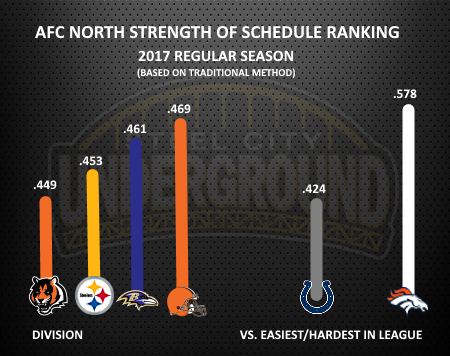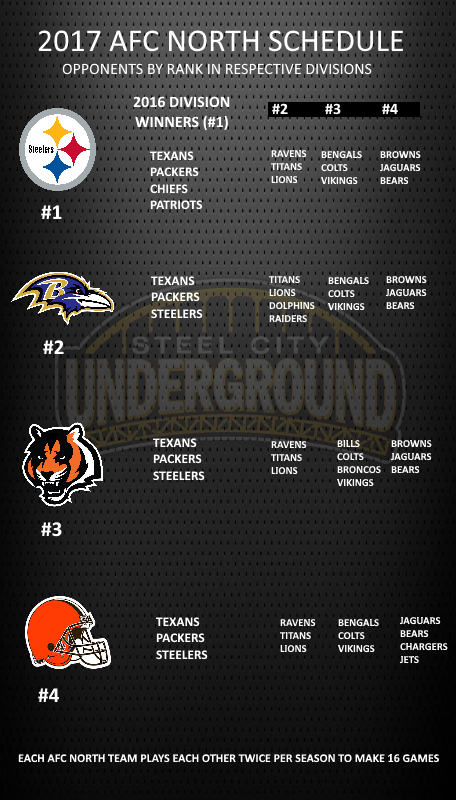Analysis of traditional strength of schedule in AFC North for 2017
The new strength of season analysis for 2017 has begun across the NFL based on what is considered a traditional method adopted since 2010 based mainly upon win-loss records of the previous regular season. Many consider this method to be antiquated and less than authentic when figuring how well a team may do in the upcoming season.
In this article, we will break down the traditional strength of schedule rankings in the AFC North.
AFC North SOS based on traditional method
For the 2017 season, all 32 teams will play four games against a 2016 division-winner, four against a team that finished second, four against a third-place team and four against a fourth-place team (16 regular season games).
Based solely on the 2016 win-loss records of the following AFC North division teams and those of the win-loss records in that same season of the opponents they will face in 2017, the NFL strength of season projections are as follows:

The Cincinnati Bengals have the easiest 2017 season in the division based on this method. Ranked 29th out of 32 teams, the Bengals had a win-loss record of six wins, nine losses and one tie (Washington Redskins) for a regular season percentage of 0.406.
Of the teams Cincinnati lost to – the Pittsburgh Steelers (x2), Denver Broncos, Dallas Cowboys, New York Giants, New England Patriots, Buffalo Bills, Baltimore Ravens and Houston Texas – five teams made it to post-season playoffs (includes wild card round.)
By combining the 2016 record of all 16 of Cincinnati’s opponents and the winning percentage, the final numbers that gave the Bengals their 2017 SOS ranking are: 115-141-0, 0.449.
The Steelers have the second easiest 2017 schedule based on the same method (tied at 27th with the Minnesota Vikings). With a regular season win-loss record of 11-5, Pittsburgh was able to take the division championship and make it to the AFC Championship game where they lost to the eventual Super Bowl Champion Patriots.
Their regular season losses came against the Philadelphia Eagles, Patriots, Ravens, Cowboys and the Miami Dolphins. Only three of those teams made it to the playoffs. That set the Steelers’ 2017 SOS ranking numbers at 115-139-2, 0.453 (T-27th.)
The Ravens came in with the second-to-hardest 2017 schedule in the division with a regular season record of 8-8 and lost to the Raiders, Redskins, Giants, New York Jets, Cowboys, Patriots, Steelers, and Bengals. Their 2017 SOS ranking numbers set them at 117-137-2, 0.461 and ranked 24th easiest schedule in the league.
Surprisingly, it is the Browns that have the hardest schedule among all AFC North teams after only winning one game in 16 total. The only team Cleveland beat in 2016 was the Chargers in Week 16. The Browns are tied with the Lions at the 21st easiest schedule in the league for 2017.
How the method determines who plays who in 2017
Under the NFL’s method, each AFC North team will play four games against a 2016 division winner. The division winners in 2016 were the following teams: Patriots (AFC East), Steelers (AFC North), Texans (AFC South), Chiefs (AFC West), Cowboys (NFC East), Packers (NFC North), Falcons (NFC South), Seahawks (NFC West).
Wait, you may say. Because the Steelers won the division, their rivals – who normally would play them twice a season anyway – get to eliminate one other division champion from their schedule? That’s correct. That leaves Pittsburgh as the lone team to face four different opponents who took their respective division in 2016.
To offset that result, each subsequent team in the division – based on their rank – then faces an additional team that finished the 2016 season with the same rank in their respective division, but not necessarily the same win-loss record.

Why the SOS matters
Strength of schedule is typically an analytical statistic that is intended to help in predicting the outcome (win versus loss) of any pairing of teams within the league. Fantasy football coaches and players, betting houses and even NFL statistics gurus lean heavily on strength of schedule predictions.
Fans, on the other hand, may simply see the predicted schedule as a tool for anticipating that their team has better odds – regardless of other statistics and player performances or roster – in beating an opponent.
Where many feel the traditional SOS is inadequate
The league’s traditional strength of schedule each year is meant to even the playing field, so to speak, by pitting teams that had a better win-loss record against other top tier teams from the season prior. It’s an imperfect system, but its intention is to create a competitive upcoming season.
The NFL’s method is geared towards weighting the rank teams finish within their division and then determine schedule by previous season win-loss records, but in many ways, this does not work out adequately or fairly.
For example, a division winner may have the same win-loss record as the #2 in their division. A team with only one win in the previous season – like the 2016 Cleveland Browns – may face teams that had incredible seasons and even went to the playoffs.
There are other situations where a division winner in one division may have a drastically more impressive win-loss record than their counterparts in other divisions.
Summary
The fact that the AFC North, as a division, is ranked low in strength bodes well for the Steelers, Ravens, Bengals, and Browns in 2017. Potentially, they could face opponents with much harder seasons making the opponents they face enter each game with more losses (or a win-loss record that is not as good as the AFC North team playing.
That would be the ideal, but in the NFL nothing is a given. In fact, one area that the traditional strength of schedule falls short on is predictability as the season progresses. Teams can buck the trend, sort of like breaking a NCAA Final Four Tournament bracket. As teams with stronger strength of schedule rankings win games they were predicted to lose, the initial predictions are skewed.
Anything can happen and those who like to play the numbers or predict outcomes of games based on head-to-head pairings do so at risk. The strength of schedule is more of a scheduling tool than a true prediction machine. Regardless, may the odds be in favor of the AFC North.
(Note: If you enjoy fantasy football and NFL statistic analysis, follow the author and Steel City Underground for upcoming articles and infographics.)









